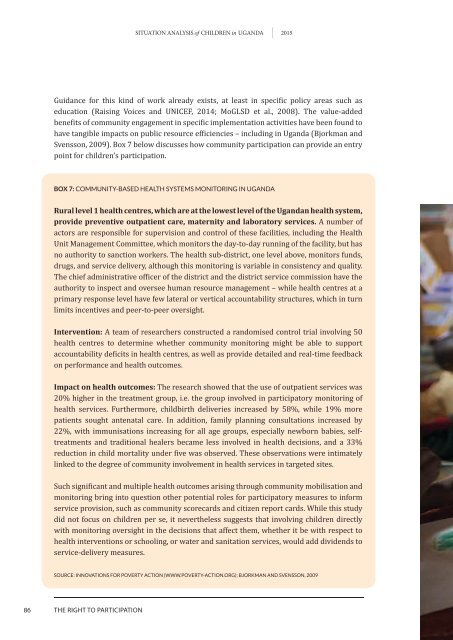Situation analySiS
1TNu802
1TNu802
Create successful ePaper yourself
Turn your PDF publications into a flip-book with our unique Google optimized e-Paper software.
<strong>Situation</strong> <strong>analySiS</strong> of Children in uganda 2015Guidance for this kind of work already exists, at least in specific policy areas such aseducation (Raising Voices and UNICEF, 2014; MoGLSD et al., 2008). The value-addedbenefits of community engagement in specific implementation activities have been found tohave tangible impacts on public resource efficiencies – including in Uganda (Bjorkman andSvensson, 2009). Box 7 below discusses how community participation can provide an entrypoint for children’s participation.BOx 7: community-bAsed heAlth systems monitorinG in uGAndARural level 1 health centres, which are at the lowest level of the Ugandan health system,provide preventive outpatient care, maternity and laboratory services. A number ofactors are responsible for supervision and control of these facilities, including the HealthUnit Management Committee, which monitors the day-to-day running of the facility, but hasno authority to sanction workers. The health sub-district, one level above, monitors funds,drugs, and service delivery, although this monitoring is variable in consistency and quality.The chief administrative officer of the district and the district service commission have theauthority to inspect and oversee human resource management – while health centres at aprimary response level have few lateral or vertical accountability structures, which in turnlimits incentives and peer-to-peer oversight.Intervention: A team of researchers constructed a randomised control trial involving 50health centres to determine whether community monitoring might be able to supportaccountability deficits in health centres, as well as provide detailed and real-time feedbackon performance and health outcomes.Impact on health outcomes: The research showed that the use of outpatient services was20% higher in the treatment group, i.e. the group involved in participatory monitoring ofhealth services. Furthermore, childbirth deliveries increased by 58%, while 19% morepatients sought antenatal care. In addition, family planning consultations increased by22%, with immunisations increasing for all age groups, especially newborn babies, selftreatmentsand traditional healers became less involved in health decisions, and a 33%reduction in child mortality under five was observed. These observations were intimatelylinked to the degree of community involvement in health services in targeted sites.Such significant and multiple health outcomes arising through community mobilisation andmonitoring bring into question other potential roles for participatory measures to informservice provision, such as community scorecards and citizen report cards. While this studydid not focus on children per se, it nevertheless suggests that involving children directlywith monitoring oversight in the decisions that affect them, whether it be with respect tohealth interventions or schooling, or water and sanitation services, would add dividends toservice-delivery measures.source: innovAtions for poverty Action (www.poverty-Action.orG); bJorKmAn And svensson, 200986 thE rIGht to PartICIPatIoN




